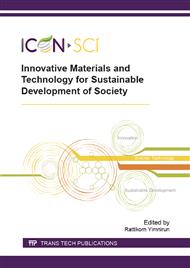[1]
D. Procházková, I. Boušová, N. Wilhelmová, Antioxidant and prooxidant properties of flavonoids, Fitoterapia. 82 (2011) 513-523.
DOI: 10.1016/j.fitote.2011.01.018
Google Scholar
[2]
R. Koes, W. Verweij, F. Quattrocchio, Flavonoids: a colorful model for the regulation and evolution of biochemical pathways, Trends Plant Sci 10 (2005) 236–242.
DOI: 10.1016/j.tplants.2005.03.002
Google Scholar
[3]
A. Dembinska-Kiec, O. Mykkänen, B. Kiec-Wilk, H. Mykkänen, Antioxidant phytochemicals against type 2 diabetes, British Journal of Nutrition. 99 (2008) 109-117.
DOI: 10.1017/s000711450896579x
Google Scholar
[4]
N. Miller, C. Rice-Evans, Spectrophotometric determination of antioxidant activity, Redox. Rep. 2(3) (1996) 161-171.
Google Scholar
[5]
J.O. Borevitz, Y. Xia, J. Blount, R.A. Dixon, C. Lamb, Activation Tagging Identifies a Conserved MYB Regulator of Phenylpropanoid Biosynthesis, The Plant Cell. 12(12) (2000) 2383-2393.
DOI: 10.1105/tpc.12.12.2383
Google Scholar
[6]
T. Tohge, Y. Nishiyama, M.Y. Hirai, M. Yano, J.I. Nakajima, M. Awazuhara, E. Inoue, H. Takahashi, D.B. Goodenowe, M. Kitayama and others, Functional genomics by integrated analysis of metabolome and transcriptome of Arabidopsis plants over-expressing an MYB transcription factor, The Plant J. 42(2) (2005).
DOI: 10.1111/j.1365-313x.2005.02371.x
Google Scholar
[7]
S. Kanthang, K. Sompornpailin, Increasing Plant Flavonoid Biomaterials in Response to UV-A Light, Adv. Mater. Res. 802 (2013) 74-78.
DOI: 10.4028/www.scientific.net/amr.802.74
Google Scholar
[8]
D. Hoagland, D. Arnon, The water-culture method for growing plants without soil, California Agricultural Experiment Station Circular. 347 (1950) 1-32.
Google Scholar
[9]
C.D. Barthelmebs, C. Jean-François, Knockout of the p-coumarate decarboxylase gene from Lactobacillus plantarum reveals the existence of two other inducible enzymatic activities involved in phenolic acid metabolism, Appl. Environ. Microb. 66(8) (2000).
DOI: 10.1128/aem.66.8.3368-3375.2000
Google Scholar
[10]
A. Harborne, Phytochemical Methods A Guide to Modern Techniques of Plant Analysis, Plant Sciences, (1998).
Google Scholar
[11]
W. Brand-Williams, M.E. Cuvelier, C. Berset, Use of a free radical method to evaluate antioxidant activity, LWT-Food Sci. Tech. 28(1) (1995) 25-30.
DOI: 10.1016/s0023-6438(95)80008-5
Google Scholar
[12]
G. Miliauskas, P.R. Venskutonis, T.A. van Beek, Screening of radical scavenging activity of some medicinal and aromatic plant extracts, Food. Chem. 85(2) (2004) 231-237.
DOI: 10.1016/j.foodchem.2003.05.007
Google Scholar
[13]
M.M. Zvi, E. Shklarman, T. Masci, H. Kalev, T Debener, S. Shafir, M. Ovadis, A. Vainstein, PAP1 transcription factor enhances production of phenylpropanoid and terpenoid scent compounds in rose flowers, New Phytologist. 195(2) (2012) 335-345.
DOI: 10.1111/j.1469-8137.2012.04161.x
Google Scholar
[14]
J. Matoušek, L. Vrba, J. Škopek, L. Orctová, K. Pešina, A. Heyerick, D. Baulcombe, D. De Keukeleire, Sequence analysis of a true, chalcone synthase (chs_H1) oligofamily from hop (Humulus lupulus L. ) and PAP1 activation of chs_H1 in heterologous systems, J. Agr. Food. Chem. 54(20) (2006).
DOI: 10.1021/jf061785g
Google Scholar
[15]
X. Li, M.J. Gao, H.Y. Pan, D.J. Cui, M.Y. Gruber, Purple canola: Arabidopsis PAP1 increases antioxidants and phenolics in Brassica napus leaves, J. Agr. Food. Chem. 58(3) (2010) 1639-1645.
DOI: 10.1021/jf903527y
Google Scholar


